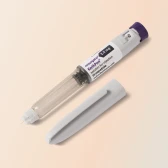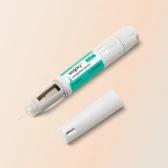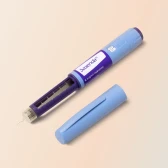Weight loss injections like Wegovy and Mounjaro are having a moment right now. You might have heard them being referred to as GLP-1 receptor agonists or peptide weight loss drugs, because of how they work (and not to be sticklers, but technically, Mounjaro is a GLP-1/GIP receptor agonist).
But thanks to their popularity, a bunch of copycat products have popped up that promise comparable results at a lower price. One of these is the so-called GLP-1 patch (sometimes called "Mounjaro patches").
Unlike weight loss injections, which are strictly regulated, GLP-1 patches are more like supplements that you stick on your skin. Don’t believe the hype around these patches. They aren’t backed by scientific evidence, so we can’t recommend them as an effective treatment for weight loss. Here’s what you need to know.
What are GLP-1 patches?
They’re adhesive patches you put on your skin that are meant to help with weight loss. The idea is that the ingredients in the patch are absorbed through your skin and stimulate production of the natural hunger hormone GLP-1, which would make you feel full (though there’s no evidence they can help with weight loss—more on that below).
Despite their name, they do not contain any GLP-1 medicines.
In fact, GLP-1 patches are not medicines at all. Medicines, such as Mounjaro weight loss injections, are tightly regulated and have to go through rigorous testing to prove they are safe and effective. Weight loss patches are basically supplements. They contain various natural extracts, like berberine, green tea, or acai berry. And they aren’t regulated in the UK.
Be careful here and take "Mounjaro patches" reviews with a pinch of salt. Just because ingredients are ‘natural’, it doesn't mean they are better. Weight loss patches haven’t been clinically tested and we can’t say for sure whether they work.
Do GLP-1 patches work for weight loss?
We cannot stress this enough. There is absolutely no scientific evidence that GLP-1 patches or "Mounjaro patches" work to help you lose weight.
While there are some studies on individual ingredients that are used in some patches, these usually look at oral supplements, which are absorbed by the body in a different way. This can’t tell us whether a patch will work or even how much of the active ingredient will be absorbed through your skin.
And if you come off your weight loss medication to try the patches, it might actually set you back. The effects of your prescribed medicine will start to wear off after about a day (if you’re on Saxenda weight loss injections) or a week (Wegovy and Mounjaro), which could cause your appetite to dial back up. Without a proper plan to gradually reduce your dose (called tapering or a “down-titration schedule”), you might end up regaining some of the weight you’ve lost.
GLP-1 patches vs injections: What’s the difference?
We know we’re repeating ourselves here, but this really is important: GLP-1 injections are regulated medicines that are supported by scientific evidence and GLP-1 patches are not.
Another obvious difference is how each product is used. Saxenda, Wegovy, and Mounjaro are meant to be injected into the fatty layer just under your skin, whereas a patch is applied to your skin like a plaster.
With medicines, the method of delivery is carefully chosen to ensure that the right amount of medicine is absorbed by the body over an acceptable amount of time. There’s nothing inherently wrong with using a patch. But we don’t yet have the scientific evidence to say that it’s an effective way to deliver weight loss medicines—nor supplements.
What about how often they’re taken? Mounjaro and Wegovy weight loss injections are meant to be used once a week, while Saxenda is taken daily. With patches, it can vary depending on the brand, but you might apply them daily or a few times per week.
Side effects of GLP-1 patches
Weight loss patches might not be medicines, but it’s possible for them to bring on side effects.
Because they haven’t been tested for safety, we don’t have a clear list of symptoms that weight loss patches could cause. Plus, because different patches contain their own set of ingredients, side effects may vary.
For example, extracts from the fruit garcinia cambogia have been reported to cause heartburn, diarrhoea, headaches, and more. Though because these studies mostly looked at pills and sachets that often combined garcinia cambogia with different ingredients, we can’t really predict what would happen if you used it in a skin patch.
To boot, the US FDA issued a warning that some weight loss supplements contain hidden ingredients (i.e. that aren’t listed on the label), including those you would find in prescription drugs. This warning wasn’t made specifically about weight loss patches, but it’s still an important consideration whenever you're beginning a new treatment.
Some people might also notice skin reactions on the application site (which is something that can happen with any medical patch or plaster).
Always check with your provider before starting any weight loss product—even if it seems ‘natural’. Remember: We can’t say that something is safe unless there’s proof to back that up.
Clinically effective weight loss
The key words here are ‘clinically effective’—a health product might promise you the world, but if it hasn’t been proven to work and be safe to take, you should steer clear of it. Taking weight loss medication alongside a healthy diet and regular exercise is backed by scientific evidence. If you stick to your schedule for at least a year, you could lose up to 25% of your starting weight.
As well as injections, there’s also Orlistat weight loss pills, which are the only tablets approved for weight in the UK. And if you’re specifically interested in non-prescription options, supplements like Glucomannan Complex capsules are available too.
Through our weight loss programme, you’ll get monthly medication plus one-to-one support from our clinicians and coaches, who will work with you to build habits that last. Check out some of our Mounjaro before and after stories to learn more. And find out if you’re eligible by taking our short quiz—it won’t take more than five minutes.












